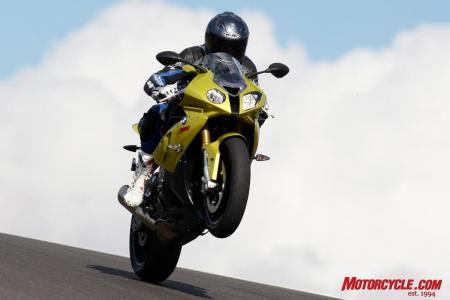
 After years of incremental increases in performance among sportbikes, along comes a fresh player to shake things up in the literbike world in a way we haven’t seen for more than a decade when the first-gen R1 debuted. BMW stepped into the fray against long-established Japanese players which have been building big transverse inline-Fours for decades. But the German brand came out swinging with a stupendous 175-plus horsepower at its rear wheel, blowing its Asian veterans out of the water by resetting a very high bar. The potential of BMW’s RR is best displayed in the World Superstock championship (closer to stock than World Superbike) where it has gone undefeated and has already wrapped up the class title. This leap in power is momentous on its own, but at least as impressive is the S1000RR’s retail price of $13,800, marginally costlier than the Japanese competitors, and much cheaper than anything from Europe. And if you ante up an extra $1,480, the Beemer gets endowed with a sophisticated electronics package that includes traction control, ABS and selectable-on-the-fly engine mapping modes. Its surplus of power and state-of-the-art electronics combine with a sure-footed chassis and enviable brakes to create a mind-bending sporting package that stands out as the most impressive motorcycle of 2010.
After years of incremental increases in performance among sportbikes, along comes a fresh player to shake things up in the literbike world in a way we haven’t seen for more than a decade when the first-gen R1 debuted. BMW stepped into the fray against long-established Japanese players which have been building big transverse inline-Fours for decades. But the German brand came out swinging with a stupendous 175-plus horsepower at its rear wheel, blowing its Asian veterans out of the water by resetting a very high bar. The potential of BMW’s RR is best displayed in the World Superstock championship (closer to stock than World Superbike) where it has gone undefeated and has already wrapped up the class title. This leap in power is momentous on its own, but at least as impressive is the S1000RR’s retail price of $13,800, marginally costlier than the Japanese competitors, and much cheaper than anything from Europe. And if you ante up an extra $1,480, the Beemer gets endowed with a sophisticated electronics package that includes traction control, ABS and selectable-on-the-fly engine mapping modes. Its surplus of power and state-of-the-art electronics combine with a sure-footed chassis and enviable brakes to create a mind-bending sporting package that stands out as the most impressive motorcycle of 2010. BMW Motorrad’s S1000RR crushed this year’s Literbike Shootout by setting precedent upon precedent. As the engineering-driven company’s first stab at the heart of highly evolved Japanese superbikes, it delivers nearly 23 more rear wheel horsepower than the next most powerful competitor, along with fantastic suspension, chassis, and brakes. This base combo by itself is class leading, but BMW also brewed in an unheard-of alphabet soup of electronic aids to make good riders faster, and faster riders into heroes. Like ‘em in principle or not, optionally available Dynamic Traction Control, Race ABS, and Gearshift Assistant further increase the competence of a machine that – despite packing in more hardware – weighs less than three of its Japanese rivals. And let’s not forget how competitively BMW priced its superior superbike – even the fully-optioned $16,480 version – for much less than Ducati kindly requests for an 1198, or KTM asks for an RC8. In fact, the $13,800 base S1000RR is within 6% or less of its 2010 Japanese rivals. Talk about knocking the ball out of the park on your first swing. Most impressive, BMW.
 |
Honorable Mention – Ducati Multistrada S
Even just a few years ago, who could’ve imagined a world in which BMW introduces a full-on sportbike that leads the literbike class, while at the same time Ducati debuts an adventure-touring-styled all-‘rounder like the Multistrada. Ducati has long been the purebred source for hardcore sporting cycles, almost always at the expense of comfort and versatility. But the Multi’s flexibility and usefulness gives it broadband appeal unavailable from any of Bologna’s other bullets.
 The Multi can’t rival BMW’s iconic GS in any off-road environment, but it excels on any other road condition. It performs with élan whether dodging commuter traffic or back-road scratching or sport touring over a long weekend. And its retuned V-Twin is easier to manage at lower revs despite a considerable 135-horse top-end wallop. At $14,995, the base Multistrada includes multi-mode engine mapping and adjustable traction control. An upgrade to the S model gets standard anti-lock Brembo brakes and Öhlins’ first electronically adjustable suspension, which allows setup changes at the touch of a button. The MTS ain’t cheap ($19,995 for the S Touring that includes hard-shell bags, heated grips and a centerstand), but it has the best combination of sport, touring and commuting that we’ve ever experienced, potentially paring down a three-bike garage to just two wheels
The Multi can’t rival BMW’s iconic GS in any off-road environment, but it excels on any other road condition. It performs with élan whether dodging commuter traffic or back-road scratching or sport touring over a long weekend. And its retuned V-Twin is easier to manage at lower revs despite a considerable 135-horse top-end wallop. At $14,995, the base Multistrada includes multi-mode engine mapping and adjustable traction control. An upgrade to the S model gets standard anti-lock Brembo brakes and Öhlins’ first electronically adjustable suspension, which allows setup changes at the touch of a button. The MTS ain’t cheap ($19,995 for the S Touring that includes hard-shell bags, heated grips and a centerstand), but it has the best combination of sport, touring and commuting that we’ve ever experienced, potentially paring down a three-bike garage to just two wheels 










